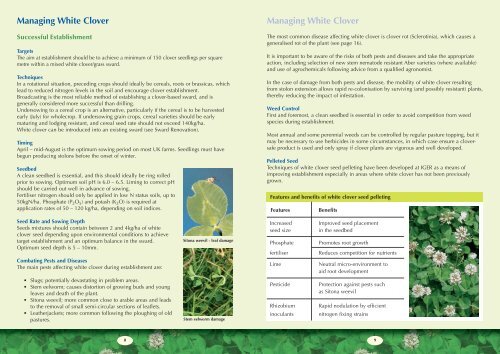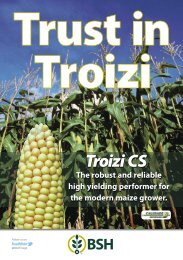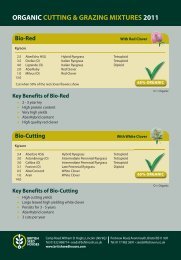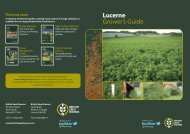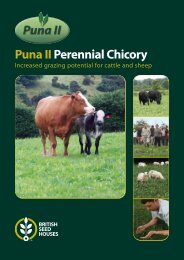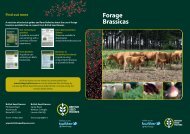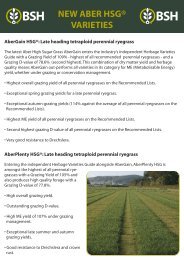You also want an ePaper? Increase the reach of your titles
YUMPU automatically turns print PDFs into web optimized ePapers that Google loves.
Managing <strong>White</strong> <strong>Clover</strong><br />
Successful Establishment<br />
Targets<br />
The aim at establishment should be to achieve a minimum of 150 clover seedlings per square<br />
metre within a mixed white clover/grass sward.<br />
Techniques<br />
In a rotational situation, preceding crops should ideally be cereals, roots or brassicas, which<br />
lead to reduced nitrogen levels in the soil and encourage clover establishment.<br />
Broadcasting is the most reliable method of establishing a clover-based sward, and is<br />
generally considered more successful than drilling.<br />
Undersowing to a cereal crop is an alternative, particularly if the cereal is to be harvested<br />
early (July) for wholecrop. If undersowing grain crops, cereal varieties should be early<br />
maturing and lodging resistant, and cereal seed rate should not exceed 140kg/ha.<br />
<strong>White</strong> clover can be introduced into an existing sward (see Sward Renovation).<br />
Timing<br />
April – mid-August is the optimum sowing period on most UK farms. Seedlings must have<br />
begun producing stolons before the onset of winter.<br />
Seedbed<br />
A clean seedbed is essential, and this should ideally be ring rolled<br />
prior to sowing. Optimum soil pH is 6.0 – 6.5. Liming to correct pH<br />
should be carried out well in advance of sowing.<br />
Fertiliser nitrogen should only be applied in low N status soils, up to<br />
50kgN/ha. Phosphate (P 2 O 5 ) and potash (K 2 O) is required at<br />
application rates of 50 – 120 kg/ha, depending on soil indices.<br />
Managing <strong>White</strong> <strong>Clover</strong><br />
The most common disease affecting white clover is clover rot (Sclerotinia), which causes a<br />
generalised rot of the plant (see page 16).<br />
It is important to be aware of the risks of both pests and diseases and take the appropriate<br />
action, including selection of new stem nematode resistant <strong>Aber</strong> varieties (where available)<br />
and use of agrochemicals following advice from a qualified agronomist.<br />
In the case of damage from both pests and disease, the mobility of white clover resulting<br />
from stolon extension allows rapid re-colonisation by surviving (and possibly resistant) plants,<br />
thereby reducing the impact of infestation.<br />
Weed Control<br />
First and foremost, a clean seedbed is essential in order to avoid competition from weed<br />
species during establishment.<br />
Most annual and some perennial weeds can be controlled by regular pasture topping, but it<br />
may be necessary to use herbicides in some circumstances, in which case ensure a cloversafe<br />
product is used and only spray if clover plants are vigorous and well developed.<br />
Pelleted Seed<br />
Techniques of white clover seed pelleting have been developed at IGER as a means of<br />
improving establishment especially in areas where white clover has not been previously<br />
grown.<br />
Features and benefits of white clover seed pelleting<br />
Features<br />
Benefits<br />
Seed Rate and Sowing Depth<br />
Seeds mixtures should contain between 2 and 4kg/ha of white<br />
clover seed depending upon environmental conditions to achieve<br />
target establishment and an optimum balance in the sward.<br />
Optimum seed depth is 5 – 10mm.<br />
Combating Pests and Diseases<br />
The main pests affecting white clover during establishment are:<br />
Sitona weevil - leaf damage<br />
Increased<br />
seed size<br />
Phosphate<br />
fertiliser<br />
Lime<br />
Improved seed placement<br />
in the seedbed<br />
Promotes root growth<br />
Reduces competition for nutrients<br />
Neutral micro-environment to<br />
aid root development<br />
• Slugs; potentially devastating in problem areas.<br />
• Stem eelworm; causes distortion of growing buds and young<br />
leaves and death of the plant.<br />
• Sitona weevil; more common close to arable areas and leads<br />
to the removal of small semi-circular sections of leaflets.<br />
• Leatherjackets; more common following the ploughing of old<br />
pastures.<br />
Stem eelworm damage<br />
Pesticide<br />
Rhizobium<br />
inoculants<br />
Protection against pests such<br />
as Sitona weevil<br />
Rapid nodulation by efficient<br />
nitrogen fixing strains<br />
8 9


